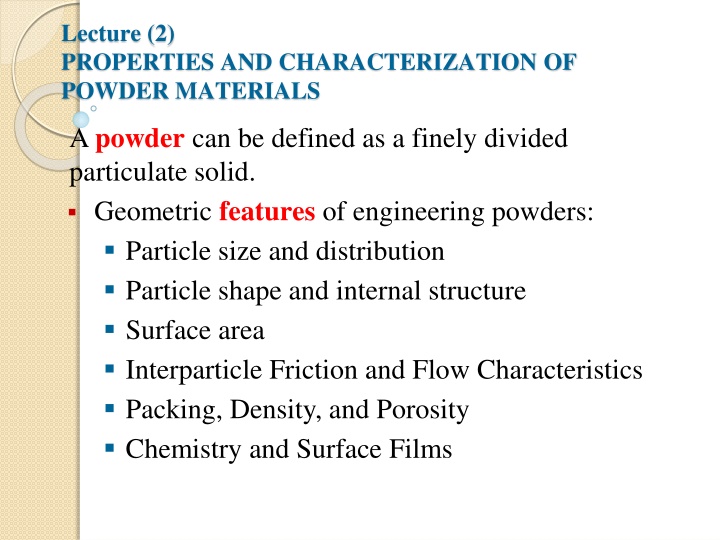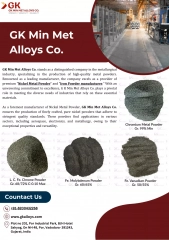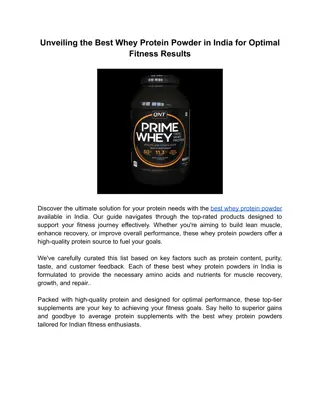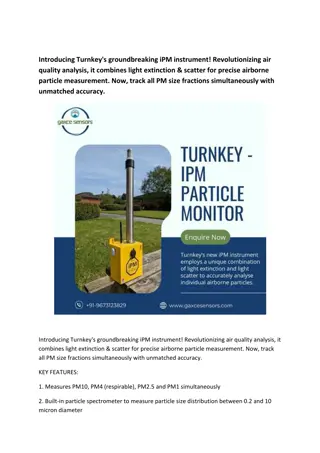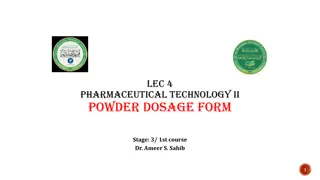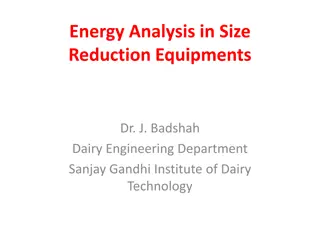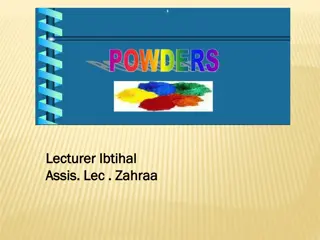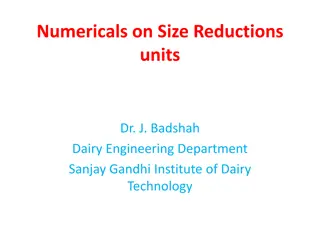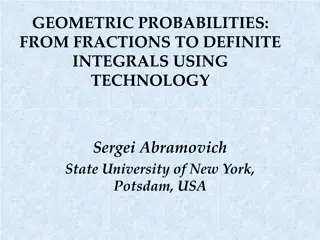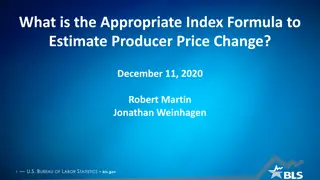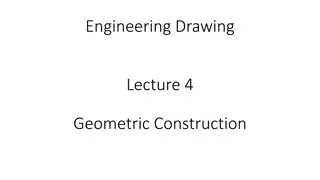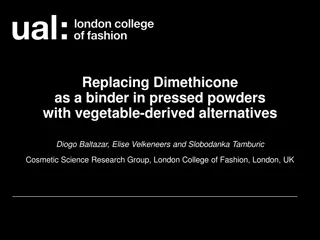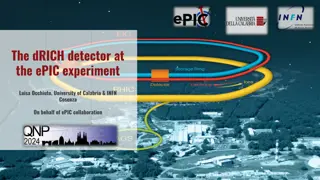Engineering Powders: Geometric Features and Particle Size Distribution
A powder is a finely divided solid with specific properties like particle size, shape, and distribution. Learn about methods for determining particle size, classification, and typical sizes used in powder metallurgy processes. Understand the importance of powder characterization in engineering applications.
Download Presentation

Please find below an Image/Link to download the presentation.
The content on the website is provided AS IS for your information and personal use only. It may not be sold, licensed, or shared on other websites without obtaining consent from the author.If you encounter any issues during the download, it is possible that the publisher has removed the file from their server.
You are allowed to download the files provided on this website for personal or commercial use, subject to the condition that they are used lawfully. All files are the property of their respective owners.
The content on the website is provided AS IS for your information and personal use only. It may not be sold, licensed, or shared on other websites without obtaining consent from the author.
E N D
Presentation Transcript
Lecture (2) PROPERTIES AND CHARACTERIZATION OF POWDER MATERIALS A powder can be defined as a finely divided particulate solid. Geometric features of engineering powders: Particle size and distribution Particle shape and internal structure Surface area Interparticle Friction and Flow Characteristics Packing, Density, and Porosity Chemistry and Surface Films
Particle Size and Distribution Particle size refers to the dimensions of the individual powders. If the particle shape is spherical, a single dimension is adequate. For other shapes, two or more dimensions are needed. There are various methods available to obtain particle size data. The most common method uses screens of different mesh sizes. The term mesh count is used to refer to the number of openings per linear inch of screen. Higher mesh count indicates smaller particle size. A mesh count of 200 means there are 200 openings per linear inch. Because the mesh is square, the count is the same in both directions, and the total number of openings per square inch is 200 = 40,000.
Particles are sorted by passing them through a series of screens of progressively smaller mesh size. The powders are placed on a screen of a certain mesh count and vibrated so that particles small enough to fit through the openings pass through to the next screen below. The second screen empties into a third, and so forth, so that the particles are sorted according to size. A certain powder size might be called size 230 through 200, indicating that the powders have passed through the 200 mesh, but not 230. The procedure of separating the powders by size is called classification. The openings in the screen are less than the reciprocal of the mesh count because of the thickness of the wire in the screen, as illustrated in Figure below. Assuming that the limiting dimension of the particle is equal to the screen opening, we have where PS = particle size, in; MC = mesh count, openings per linear inch; and tw = wire thickness of screen mesh, in.
The figure (2) shows how smaller particles would pass through the openings, whereas larger powders would not. Variations occur in the powder sizes sorted by screening owing to differences in particle shapes, the range of sizes between mesh count steps, and variations in screen openings within a given mesh count. Also, the screening method has a practical upper limit of MC = 400 (approximately), because of both the difficulty in making such fine screens and agglomeration of the small powders. Other methods to measure particle size include microscopy and X- ray techniques. Typical particle sizes used in conventional powder metallurgy (press and sinter) range between 25 and 300 mm(0.001 and 0.012 in).1 The high end of this range corresponds to a mesh count of around 65. The low end of the range is too small to be measured by the mesh count method.
Particle Shape and Internal Structure Metal powder shapes can be cataloged into various types, several of which are illustrated in Figure below A simple and useful measure of shape is the aspect ratio - the ratio of maximum dimension to minimum dimension for a given particle. The aspect ratio for a spherical particle is 1.0, but for an acicular grain the ratio might be 2 to 4. Microscopic techniques are required to determine shape characteristics. Any volume of loose powders will contain pores between the particles. These are called open pores because they are external to the individual particles. Open pores are spaces into which a fluid such as water, oil, or a molten metal can penetrate. In addition, there are closed pores - internal voids in the structure of an individual particle. The existence of these internal pores is usually minimal, and their effect when they do exist is minor, but they can influence density measurements, as we shall see later.
Figure below: Several of the possible (ideal) particle shapes in powder metallurgy.
Surface Area Assuming that the particle shape is a perfect sphere, its area A and volume V are given by where D = diameter of the spherical particle, mm (in). The area-to-volume ratioA/V for a sphere is then given by In general, the area-to-volume ratio can be expressed for any particle shape spherical or nonspherical as follows: where Ks = shape factor; D in the general case = the diameter of a sphere of equivalent volume as the nonspherical particle, mm (in). Thus, Ks = 6.0 for a sphere. For particle shapes other than spherical, Ks > 6.
Interparticle Friction and Flow Characteristics Friction between particles affects the ability of a powder to flow readily and pack tightly. A common measure of interparticle friction is the angle of repose, which is the angle formed by a pile of powders as they are poured from a narrow funnel. Larger angles indicate greater friction between particles. Smaller particle sizes generally show greater friction and steeper angles. Spherical shapes result in the lowest interpartical friction; as shape deviates more from spherical, friction between particles tends to increase.
Flow characteristics are important in die filling and pressing. Automatic die filling depends on easy and consistent flow of the powders. In pressing, resistance to flow increases density variations in the compacted part; these density gradients are generally undesirable. A common measure of flow is the time required for a certain amount of powder (by weight) to flow through a standard-sized funnel. Smaller flow times indicate easier flow and lower Interparticle friction. To reduce interparticle friction and facilitate flow during pressing, lubricants are often added to the powders in small amounts.
Packing, Density, and Porosity Packing characteristics depend on two density measures. First, true density is the density of the true volume of the material. This is the density when the powders are melted into a solid mass. Second, bulk density is the density of the powders in the loose state after pouring, which includes the effect of pores between particles. Because of the pores, bulk density is less than true density. The packing factor is the bulk density divided by the true density. Typical values for loose powders range between 0.5 and 0.7. The packing factor depends on particle shape and the distribution of particle sizes. If powders of various sizes are present, the smaller powders will fit into the interstices of the larger ones that would otherwise be taken up by air, thus resulting in a higher packing factor.
Packing can also be increased by vibrating the powders, causing them to settle more tightly. Finally, we should note that external pressure, as applied during compaction, greatly increases packing of powders through rearrangement and deformation of the particles. Porosity represents an alternative way of considering the packing characteristics of a powder. Porosity is defined as the ratio of the volume of the pores (empty spaces) in the powder to the bulk volume. In principle Porosity + Packing factor = 1 The issue is complicated by the possible existence of closed pores in some of the particles. If these internal pore volumes are included in the above porosity, then the equation is exact.
Chemistry and Surface Films Characterization of the powder would not be complete without an identification of its chemistry. Metallic powders are classified as either elemental, consisting of a pure metal, or pre-alloyed, wherein each particle is an alloy. Surface films are a problem in powder metallurgy because of the large area per unit weight of metal when dealing with powders. The possible films include oxides, silica, adsorbed moisture. Generally, these films must be removed before shape processing. organic materials, and
